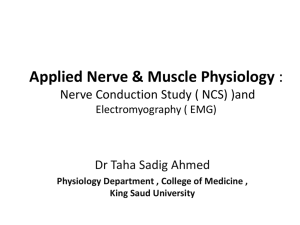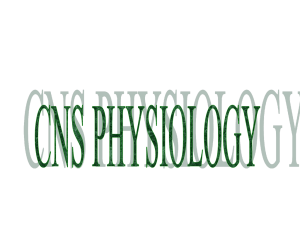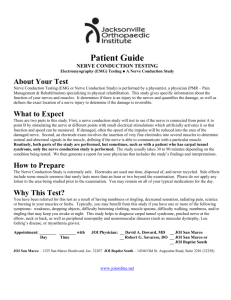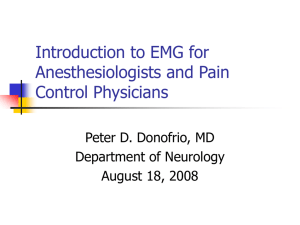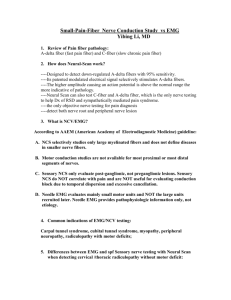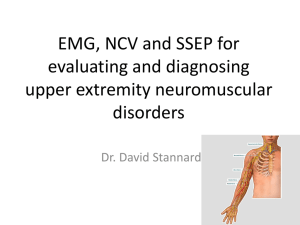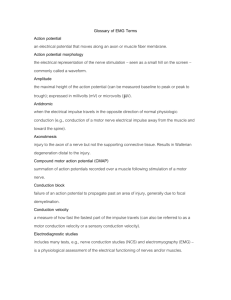Doc - Shaw Chiropractic
advertisement
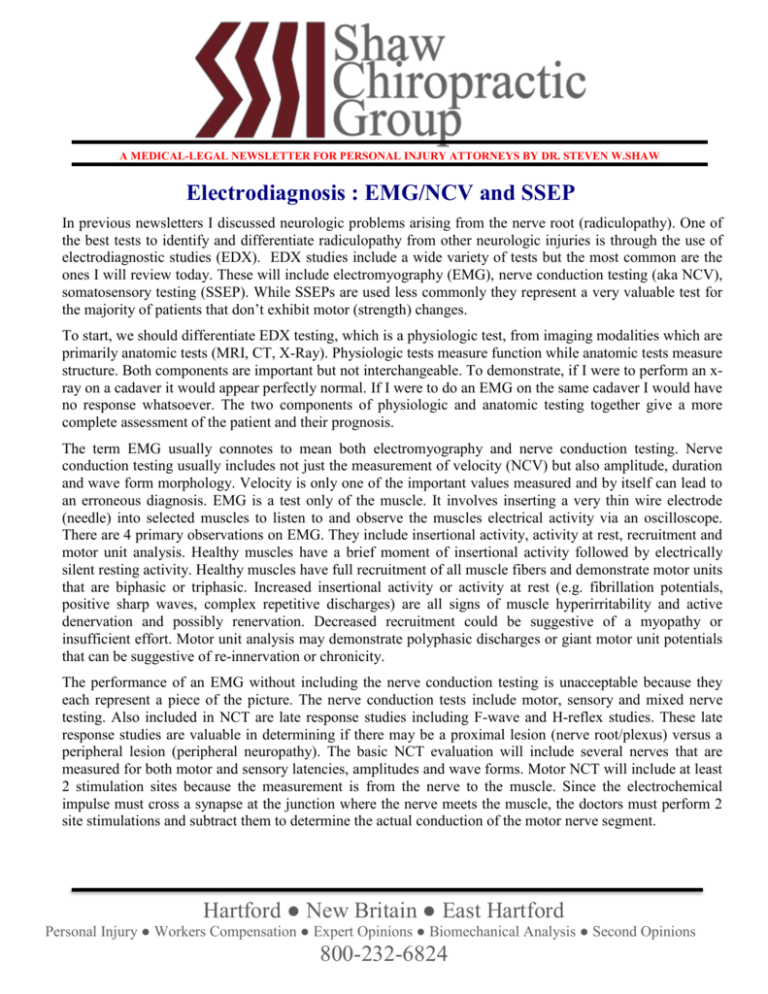
A MEDICAL-LEGAL NEWSLETTER FOR PERSONAL INJURY ATTORNEYS BY DR. STEVEN W.SHAW Electrodiagnosis : EMG/NCV and SSEP In previous newsletters I discussed neurologic problems arising from the nerve root (radiculopathy). One of the best tests to identify and differentiate radiculopathy from other neurologic injuries is through the use of electrodiagnostic studies (EDX). EDX studies include a wide variety of tests but the most common are the ones I will review today. These will include electromyography (EMG), nerve conduction testing (aka NCV), somatosensory testing (SSEP). While SSEPs are used less commonly they represent a very valuable test for the majority of patients that don’t exhibit motor (strength) changes. To start, we should differentiate EDX testing, which is a physiologic test, from imaging modalities which are primarily anatomic tests (MRI, CT, X-Ray). Physiologic tests measure function while anatomic tests measure structure. Both components are important but not interchangeable. To demonstrate, if I were to perform an xray on a cadaver it would appear perfectly normal. If I were to do an EMG on the same cadaver I would have no response whatsoever. The two components of physiologic and anatomic testing together give a more complete assessment of the patient and their prognosis. The term EMG usually connotes to mean both electromyography and nerve conduction testing. Nerve conduction testing usually includes not just the measurement of velocity (NCV) but also amplitude, duration and wave form morphology. Velocity is only one of the important values measured and by itself can lead to an erroneous diagnosis. EMG is a test only of the muscle. It involves inserting a very thin wire electrode (needle) into selected muscles to listen to and observe the muscles electrical activity via an oscilloscope. There are 4 primary observations on EMG. They include insertional activity, activity at rest, recruitment and motor unit analysis. Healthy muscles have a brief moment of insertional activity followed by electrically silent resting activity. Healthy muscles have full recruitment of all muscle fibers and demonstrate motor units that are biphasic or triphasic. Increased insertional activity or activity at rest (e.g. fibrillation potentials, positive sharp waves, complex repetitive discharges) are all signs of muscle hyperirritability and active denervation and possibly renervation. Decreased recruitment could be suggestive of a myopathy or insufficient effort. Motor unit analysis may demonstrate polyphasic discharges or giant motor unit potentials that can be suggestive of re-innervation or chronicity. The performance of an EMG without including the nerve conduction testing is unacceptable because they each represent a piece of the picture. The nerve conduction tests include motor, sensory and mixed nerve testing. Also included in NCT are late response studies including F-wave and H-reflex studies. These late response studies are valuable in determining if there may be a proximal lesion (nerve root/plexus) versus a peripheral lesion (peripheral neuropathy). The basic NCT evaluation will include several nerves that are measured for both motor and sensory latencies, amplitudes and wave forms. Motor NCT will include at least 2 stimulation sites because the measurement is from the nerve to the muscle. Since the electrochemical impulse must cross a synapse at the junction where the nerve meets the muscle, the doctors must perform 2 site stimulations and subtract them to determine the actual conduction of the motor nerve segment. Hartford ● New Britain ● East Hartford Personal Injury ● Workers Compensation ● Expert Opinions ● Biomechanical Analysis ● Second Opinions 800-232-6824 A MEDICAL-LEGAL NEWSLETTER FOR PERSONAL INJURY ATTORNEYS BY DR. STEVEN W.SHAW The performance of a thorough EMG/NCV examination will help determine the location, extent and chronicity of a lesion. It can isolate a lesion to the specific segment of the motor or sensory nerve, the muscle or the motor neuron junction (synapse). Unfortunately, to be measurable there needs to be significant compromise and many nerve and muscle injuries do not reach the threshold to be electrodiagnostically verified. In fact, one of my professors at the EDX lab at Albany Medical College told me that even with a carefully selected patient population only 30-40% of patients will demonstrate abnormal EDX findings, even if they have clinical symptoms consistent with the diagnosis. In other words, a normal EMG study does not mean that there is no nerve or muscle abnormality. Rather, it means that it cannot be measured electrodiagnostically. This is partially due to the fact that only the fast myelinated nerve fibers are measured during NCT testing while pain carrying C-Fiber nerves are generally unmyelinated and not measurable via routine EDX studies. In summary, EDX testing is very valuable in elucidating the presence and extent of a neuromuscular condition and can add very valuable prognostic information. Unfortunately, the sensitivity of the test is somewhat lacking although the specificity can be high when properly performed. Hartford ● New Britain ● East Hartford Personal Injury ● Workers Compensation ● Expert Opinions ● Biomechanical Analysis ● Second Opinions 800-232-6824




